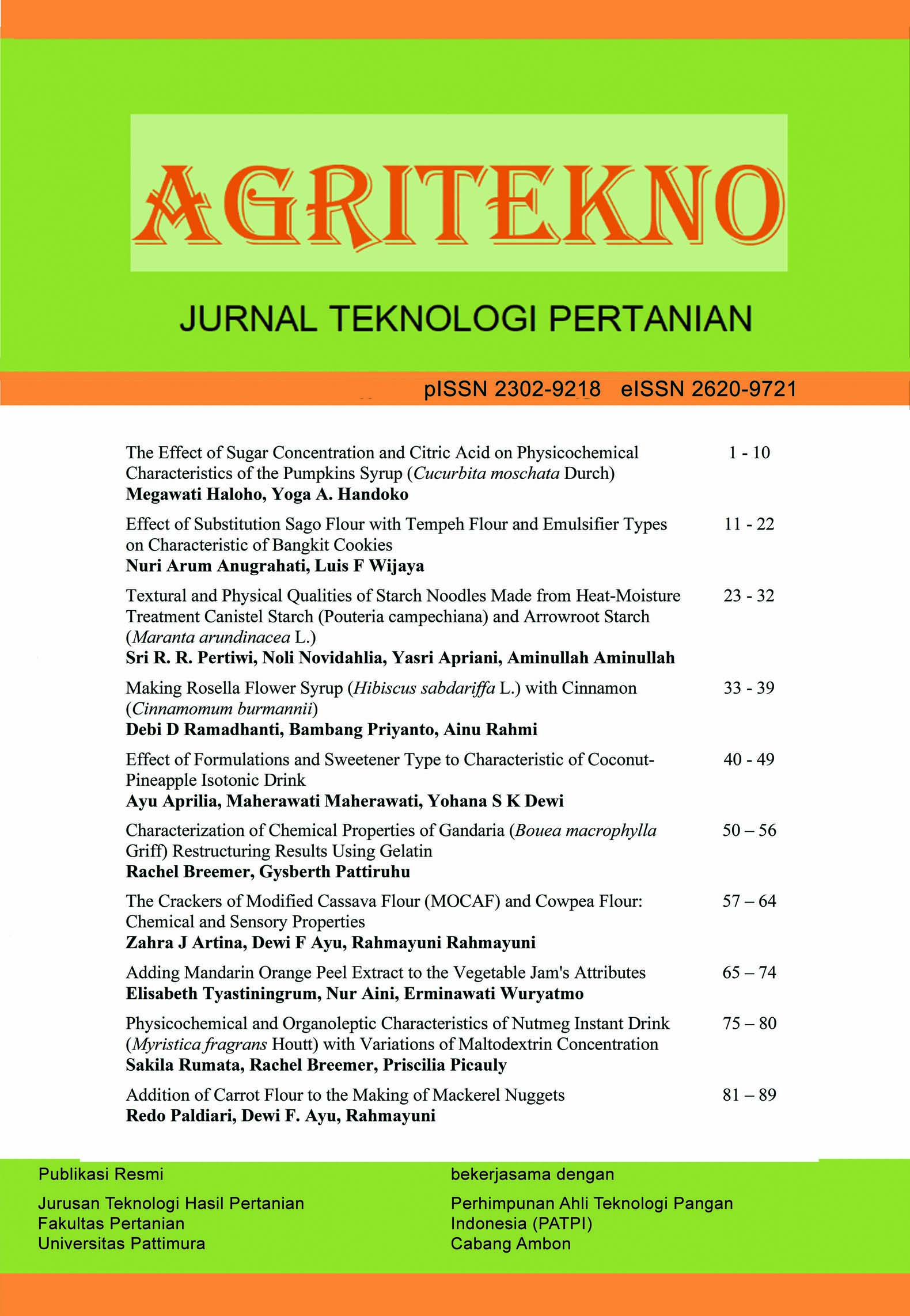Making Rosella Flower Syrup (Hibiscus sabdariffa L.) with Cinnamon (Cinnamomum burmannii)
Abstract
This study aimed to determine the exact cinnamon concentration in the manufacture of rosella flower petal syrup based on its physical and chemical properties. A completely randomized experimental design with six levels of cinnamon concentration, i.e., 0, 1, 3, 5, 7, and 9 g, respectively, replicated four times was applied in this research. Analyses were performed on both the concentrated and diluted forms of the syrup. Parameters observed were sensory tests (aroma, taste, and color), physical tests on viscosity, and chemical tests (sugar content, pH, and vitamin C). Observation parameters include organoleptic tests (color, taste, and aroma) by untrained panelists, viscosity using a digital viscometer, chemical tests of sugar content on a refractometer, pH on a pH meter, and vitamin C using an iodometric method. Observational data were analyzed using the analysis of variance. If the value of the F-table is significant then followed by Duncan's New multiple range test (α = 0.05) and Friedman analysis for sensory tests. The exact concentration of the addition of cinnamon in making rosella flower petal syrup was 9 g (K6) based on sensory parameters (taste) with a mean rank of 17,84, viscosity/thickness of 46,325 cP, based on the results of the De Garmo effectiveness index test, the pH of the concentrated syrup was 3,350 and the pH of the diluted syrup was 3,625; the sugar content of the concentrated syrup was 66,75°brix.
Downloads
References
Agusman, A. (2013). Pengujian Organoleptik Teknologi Pangan. Semarang: Universitas Muhamadiyah Semarang.
Aina, M., & Suprayogi, D. (2010). Uji kualitatif vitamin C pada berbagai makanan dan pengaruhnya terhadap pemanasan. Journal of Chemical Information and Modeling, 53(9), 287. http://online-journal.unja.ac.id/index.php/sainmatika/article/view/1615/1072
Ananta, A. A. B., Karyantia, M., & Widanti, Y. A. (2019). Formulasi sirup herbal daun Kelor (Morringa oleifera) dengan ekstrak bunga Rosella (Hibiscus sabdariffa L.). Jurnal Ilmiah Teknologi dan Industri Pangan UNISRI, 4(2), 41–47. https://doi.org/https://doi.org/10.33061/jitipari.v4i2.3145
Apriliani, R., Tamrin, & Hermanto. (2019). Pengaruh penambahan Kayu Manis (Cinnamomum Verum) Terhadap karakteristik organoleptik dan antioksidan minuman sari buah Alpukat (Perseaamericana Mill). Jurnal Sains dan Teknologi Pangan, 4(6), 2621–2634.
Asrawaty, Noer, H., & Wahyudin. (2017). Karakteristik fisik kimia dan organoleptik sirup buah mangga pada penambahan gula yang berbeda. Jurnal Ilmu-Ilmu Pertanian, 1(2), 1–8.
Badan Standardisasi Nasional. SNI 01-2891- 1992. Cara Uji Makanan dan Minuman. 1992. [diakses pada 16 April 2022]. Didapatkan dari: https://kupdf.com/download/sni-01-2891- 1992-cara-uji-makanan-danminumanpdf_59db639108bbc5207e434f3a_ pdf
Badan Standarisasi Nasional Indonesia. (2013). SNI Sirup 3544:2013
Ferry, Y. F. Y. (2013). Prospek pengembangan Kayu Manis (Cinnamomum Burmanii L) di Indonesia. Balittri Sirinov, 1(1), 11–20.
Hadiwijaya, H. H. H. (2013). Pengaruh perbedaan penambahan gula terhadap karakteristik sirup Buah Naga (Hylocereus polyrhizus). J Conserv Dent. 2013, 16(4), 2013. https://pubmed.ncbi.nlm.nih.gov/23956527/
Marwita, M., Efendi, R., & Rossi, E. (2022). Konsentrasi Kayu Manis terhadap mutu manisan empulur Buah Nanas (Ananas comosus L. Merr) selama penyimpanan. Jurnal Sagu, 20(2), 49. https://doi.org/10.31258/sagu.20.2.p.49-59
Masriatini, R. (2018). Penambahan gula terhadap mutu sirup Mangga. Jurnal Redoks, 3(1), 33–36. https://jurnal.univpgri-palembang.ac.id/index.php/redoks/article/view/2789
Ngafifuddin, M., Sunarno, S., & Susilo, S. (2017). Penerapan rancang bangun pH Meter berbasis arduino pada mesin pencuci film radiografi sinar-X. Jurnal Sains Dasar, 6(1), 66. https://doi.org/10.21831/jsd.v6i1.14081
Nurnasari, E., & Khuluq, A. D. (2018). Potensi diversifikasi Rosela Herbal (Hibiscus sabdariffa L.) untuk pangan dan kesehatan. Buletin Tanaman Tembakau, Serat & Minyak Industri, 9(2), 82. https://doi.org/10.21082/btsm.v9n2.2017.82-92
Palupi, H. T. P. H. T. (2015). Pengaruh konsentrasi ekstrak daun Cincau Hijau (Cyclea barbata L. Miers) dan suhu ekstraksi terhadap karakteristik Mie Basah. Teknologi Pangan : Media Informasi dan Komunikasi Ilmiah Teknologi Pertanian, 6(1). https://doi.org/10.35891/tp.v6i1.465
Rusita, Y. D. (2017). Terapi Herbal Buah dan Sayuran Untuk 10 Penyakit Berbahaya. Galmas Publisher: Surakarta.
Saputra, S. A., Lailiyah, M., & Atika, S. T. R. (2020). Formulasi Gel Pewarna Rambut Dari Sari Daun Tarum (Indigofera tinctoria L.) Dengan Basis Carbopol 940. Prosiding Seminar Hasil penelitian 2020. Seminar Hasil Penelitian Tahun 2020 Diseminasi Hasil Penelitian Untuk Meningkatan Kesehatan, 75–83.
Saragih, C., Herawati, N., & Efendi, R. (2017). Pembuatan sirup Ubi Jalar Ungu (Ipomea batatas L.) dengan penambahan sari Lemon (Citrus limon L.). Jurnal Onlline Mahasiswa Fakultas Pertanian Universitas Riau, 4(2355–6838), 514–520.
Shafira, F. A. S. F. A. (2017). Praktikum Analisis Kadar Gula Reduksi, Gula Total Dan Pati Fakultas Teknologi Industri Pertanian Universitas Padjajaran. 240210140022, 2020.
Silvia, A., & Oktaviani, P. (2019). Pengaruh konsentrasi larutan gula terhadap sediaan sirup Seledri (Apium graveolens L.). Viva Medika: Jurnal Kesehatan, Kebidanan dan Keperawatan, 10(2), 1–8. https://doi.org/10.35960/vm.v10i2.440
Copyright (c) 2023 The Author(s)

This work is licensed under a Creative Commons Attribution-ShareAlike 4.0 International License.
Authors who publish with this journal agree to the following terms:
- Authors retain copyright and grant the journal the right of first publication with the work simultaneously licensed under a Creative Commons Attribution License that allows others to share the work with an acknowledgement of the work's authorship and initial publication in this journal.
- Authors are able to enter into separate, additional contractual arrangements for the non-exclusive distribution of the journal's published version of the work (e.g., post it to an institutional repository or publish it in a book), with an acknowledgement of its initial publication in this journal.
- Authors are permitted and encouraged to post their work online (e.g., in institutional repositories or on their website) prior to and during the submission process, as it can lead to productive exchanges, as well as earlier and greater citation of published work (See The Effect of Open Access).









